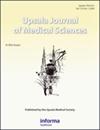用于 SPECT 成像的脑穿透性 Aβ 抗体的铟-111 放射性标记
IF 1.5
4区 医学
Q2 MEDICINE, GENERAL & INTERNAL
引用次数: 0
摘要
背景:能穿越血脑屏障的双特异性抗体的开发为脑定向免疫疗法以及放射性标记后的免疫 PET 成像铺平了道路。本研究的目的是探讨铟-111(111In)放射性标记与兼容螯合剂如何影响双特异性抗体RmAb158-scFv8D3在表达淀粉样β(Aβ)的tg-ArcSwe小鼠和年龄匹配的野生型对照小鼠中的脑输送和外周生物分布。研究方法使用 CHX-A"-DTPA、DOTA 或 DOTA-四嗪(DOTA-Tz)用 111In 放射性标记双特异性 RmAb158-scFv8D3(biAb)。对 TfR 和 Aβ 的亲和力以及稳定性进行了体外研究。然后给小鼠静脉注射三种不同的放射性标记生物抗体变体,并收集血液样本以监测药代动力学。2 小时和 72 小时后对脑部浓度进行量化,72 小时后通过伽马计数测量器官特异性保留。一部分小鼠还在注射后 72 小时接受了全身单光子发射计算机断层扫描(SPECT)。尸体分离后,对 tg-ArcSwe 和 WT 小鼠的大脑进行切片,并通过自显影进一步研究生物抗体的空间分布。结果:所有三种[111In]生物标记变体在给药后 2 小时都显示出相似的血液药代动力学和脑摄取。放射性标记不会影响亲和力,所有变体都表现出良好的稳定性,尤其是 DOTA-Tz 变体。全身SPECT扫描显示,所有[111In]生物标记变体的肝、脾和骨蓄积量都很高。随后进行的体外器官滞留测量证实了 SPECT 数据,脾脏、肝脏和骨骼均有滞留,其中骨髓滞留率极高。注射后 72 小时分离的脑组织的体内伽马测量和体内自显影显示,尽管 WT 小鼠体内没有 Aβ,但其脑中的[111In]biAb 浓度与 tg-ArcSwe 脑中的浓度相当。结论111In标记的生物标记物成功地保留了与TfR和Aβ的结合,并保留了进入大脑的能力,这表明111In可用于产生脑成像的放射性配体。骨髓中[111In]biAb的高浓度和脑组织中的细胞内积累表明存在一些脱靶相互作用或与脑内TfR的潜在相互作用,从而导致相对较高的非特异性背景信号。本文章由计算机程序翻译,如有差异,请以英文原文为准。
Indium-111 radiolabelling of a brain-penetrant Aβ antibody for SPECT imaging
Background: The development of bispecific antibodies that can traverse the blood–brain barrier has paved the way for brain-directed immunotherapy and when radiolabelled, immunoPET imaging. The objective of this study was to investigate how indium-111 (111In) radiolabelling with compatible chelators affects the brain delivery and peripheral biodistribution of the bispecific antibody RmAb158-scFv8D3, which binds to amyloid-beta (Aβ) and the transferrin receptor (TfR), in Aβ pathology-expressing tg-ArcSwe mice and aged-matched wild-type control mice.
Methods: Bispecific RmAb158-scFv8D3 (biAb) was radiolabelled with 111In using CHX-A”-DTPA, DOTA, or DOTA-tetrazine (DOTA-Tz). Affinity toward TfR and Aβ, as well as stability, was investigated in vitro. Mice were then intravenously administered with the three different radiolabelled biAb variants, and blood samples were collected for monitoring pharmacokinetics. Brain concentration was quantified after 2 and 72 h, and organ-specific retention was measured at 72 h by gamma counting. A subset of mice also underwent whole-body Single-photon emission computed tomography (SPECT) scanning at 72 h after injection. Following post-mortem isolation, the brains of tg-ArcSwe and WT mice were sectioned, and the spatial distribution of biAb was further investigated with autoradiography.
Results: All three [111In]biAb variants displayed similar blood pharmacokinetics and brain uptake at 2 h after administration. Radiolabelling did not compromise affinity, and all variants showed good stability, especially the DOTA-Tz variant. Whole-body SPECT scanning indicated high liver, spleen, and bone accumulation of all [111In]biAb variants. Subsequent ex vivo measurement of organ retention confirmed SPECT data, with retention in the spleen, liver, and bone – with very high bone marrow retention. Ex vivo gamma measurement of brain tissue, isolated at 72 h post-injection, and ex vivo autoradiography showed that WT mice, despite the absence of Aβ, exhibited comparable brain concentrations of [111In]biAb as those found in the tg-ArcSwe brain.
Conclusions: The successful 111In-labelling of biAb with retained binding to TfR and Aβ, and retained ability to enter the brain, demonstrated that 111In can be used to generate radioligands for brain imaging. A high degree of [111In]biAb in bone marrow and intracellular accumulation in brain tissue indicated some off-target interactions or potential interaction with intrabrain TfR resulting in a relatively high non-specific background signal.
求助全文
通过发布文献求助,成功后即可免费获取论文全文。
去求助
来源期刊

Upsala journal of medical sciences
医学-医学:内科
CiteScore
5.60
自引率
0.00%
发文量
31
审稿时长
6-12 weeks
期刊介绍:
Upsala Journal of Medical Sciences is published for the Upsala Medical Society. It has been published since 1865 and is one of the oldest medical journals in Sweden.
The journal publishes clinical and experimental original works in the medical field. Although focusing on regional issues, the journal always welcomes contributions from outside Sweden.
Specially extended issues are published occasionally, dealing with special topics, congress proceedings and academic dissertations.
 求助内容:
求助内容: 应助结果提醒方式:
应助结果提醒方式:


